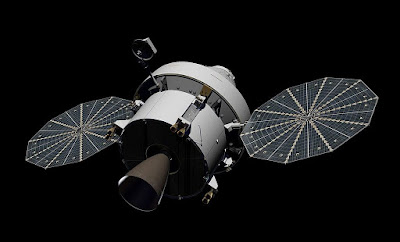 |
| Orion spacecraft - courtesy NASA |
A manned mission to mine an asteroid will take 4 people and cost about 50 billion dollars. That is based on NASA’s original estimate of the first Mars mission using 4 people and and costing 500 billion dollars. The logic is that it takes private industry 1/10 the resources to do the same thing the government can do. Witness Elon Musk reducing per pound costs of launching material into space from $10,000 to $1,000 over a period of a few years. Also, these are asteroids that intersect Earth’s orbit once or twice in their rotation about the Sun. Therefore, they are potentially much closer than Mars.
A mission run and crewed by AI and robotic drones would be cheaper, perhaps by another factor of 10, making it only a 5 billion dollar mission. Here’s why.
A manned mission requires a spaceship, like Elon Musk's Starship, to get there and stay there during the mission. It must carry food, water, radiation shielding, air, living quarters, medical supplies, and all the other necessary paraphernalia of human existence. An AI mission could be towed there behind an AI controlled rocket attached to a giant fuel tank; a relatively cheap arrangement.
Keep in mind, the lead up to actually going after any particular asteroid will involve many flights by drones and semi-autonomous satellites to determine which one to go to and what the pay-off might be. Towards the end of this diaspora of electronic treasure sniffers, the AI satellite drones will have already taken over. This whole process has only just begun with Hyabasa2, Japan’s latest mission to the asteroid Ryugu, and OSIRIS-REx, NASA’s mission to the asteroid Bennu.
Not only would humans have to endure the trip to and from the asteroid, it may take some time to set up operations and produce enough refined material to make the trip worth the investment. They may have to stay with that asteroid for a complete orbit of the Sun taking between 300 to 1,500 days or longer. This path could take them inward closer than Mercury to the Sun or outward nearly to Jupiter. These are extreme conditions of solar flux density; energy dense but frying close to the Sun and energy sparse and freezing out by Jupiter. Toward the outer edges of the asteroid belt, it may require a small nuclear reactor for humans to survive those cold dark regions, whereas machines could go into a minimal hibernation mode if they run low on spare battery power. As they get closer to the Sun, the machines would automatically spring to life.
So, to answer the question posed by the title, I have to go with AI. As to when this happens, artificial intelligence wonks say there will be a generalized AI within twenty years. So far, we have produced only specialized artificial intelligence. These programs are, more or less, idiot savants knowing a lot about narrow subjects. Generalized AI will take a broader view of things, more like a normal human. They will be competent to take on this task. I predict the first production mining mission to an asteroid will begin twenty years from now if probes return with positive results, and it will be fully automated with a generalized AI.
Hopefully, they will not propagate among the asteroids and return as a spacefaring army to conquer Earth. Bwahahahahaha! Kidding.
Other articles you may enjoy:
Hopefully, they will not propagate among the asteroids and return as a spacefaring army to conquer Earth. Bwahahahahaha! Kidding.
Other articles you may enjoy:

No comments:
Post a Comment